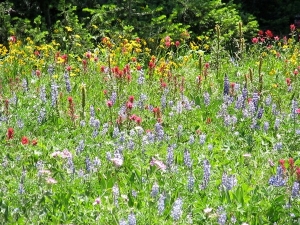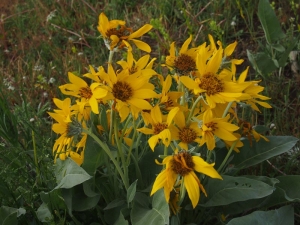Wildflowers in Grand Teton and Yellowstone Parks
 The wildflower season throughout the Greater Yellowstone Ecosystem has been incredible this year! A long runoff of snow melt and occasional rain throughout the early summer combined with warm temperatures has created the perfect conditions for long-lasting blooms across the Jackson Hole valley.
The wildflower season throughout the Greater Yellowstone Ecosystem has been incredible this year! A long runoff of snow melt and occasional rain throughout the early summer combined with warm temperatures has created the perfect conditions for long-lasting blooms across the Jackson Hole valley.
Early blooms of Arrowleaf Balsamroot with their silvery-haired arrow-shaped leaves and daisy-like yellow flowers gave way to Mule’s Ear in early June. Commonly confused with each other, Mule’s Ear has waxy, shiny leaves but very similar flowers.
Lupine sprang up in mid-June. A long, multi-bloomed stalk, also called an inflorescence, stands prominently across the valley, its light purple hue complimenting the silvery green of the sagebrush. As the summer heat has dried out the soil, lupines have begun to produce seeds. They are part of the legume family, so their seed pods may look familiar, much like soy beans. In fact, other species of lupine are edible, and are a favorite bar food in Portugal, Spain, and South America.
 The newest addition to our wildflower bouquet so far has been the Indian Paintbrush. Sometimes called Prairie Fire, Indian paintbrush appears in this area as a tall stalk with enlarged leaves at the top forming petals that are tipped with red and occasionally pale yellow. Indian paintbrush was used by Native Americans for several uses, from medicinal (enhanced immune system function) to cosmetic (shiny, full-bodied hair). Large meadows of these flowers can truly look like they are aflame, and single flowers look ready to pluck and paint with, simply dripping with color!
The newest addition to our wildflower bouquet so far has been the Indian Paintbrush. Sometimes called Prairie Fire, Indian paintbrush appears in this area as a tall stalk with enlarged leaves at the top forming petals that are tipped with red and occasionally pale yellow. Indian paintbrush was used by Native Americans for several uses, from medicinal (enhanced immune system function) to cosmetic (shiny, full-bodied hair). Large meadows of these flowers can truly look like they are aflame, and single flowers look ready to pluck and paint with, simply dripping with color!
As the summer heats up, search for wildflowers up the mountainsides. The blooming sequence follows the climate, so when the valley floor is too hot for these delicate blossoms, they begin to appear at cooler high elevations. If you venture high enough, you may also see specialized alpine flowers, such as Glacier Lily or Alpine Forget-Me-Not.
Karyn Greenwood, Buffalo Roam Tours Guide


